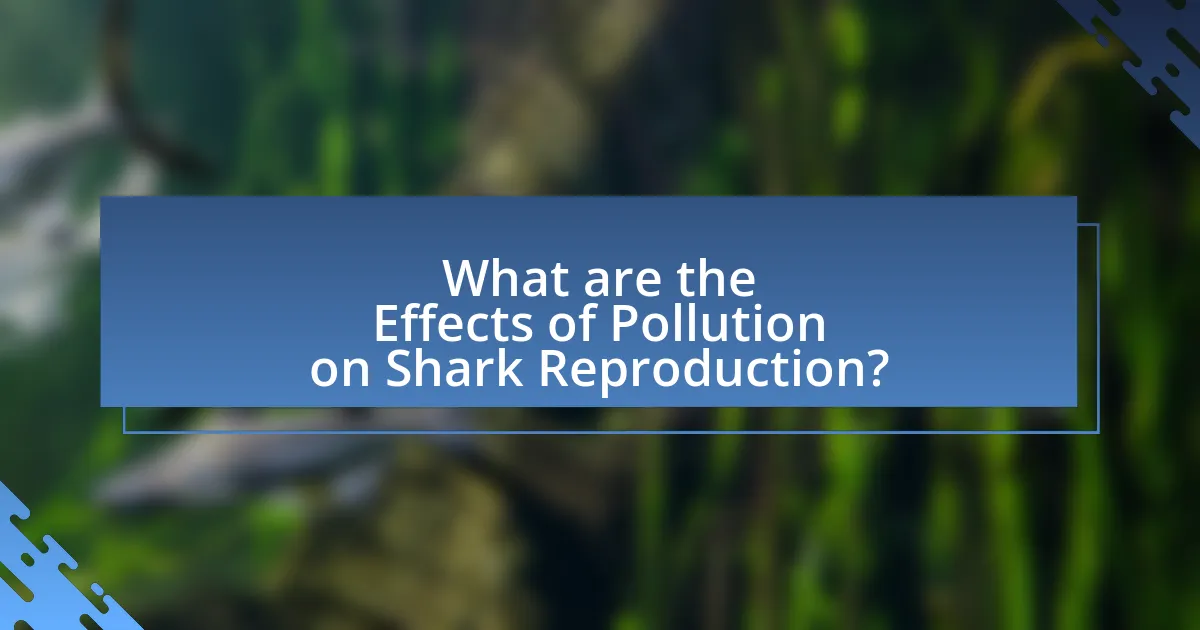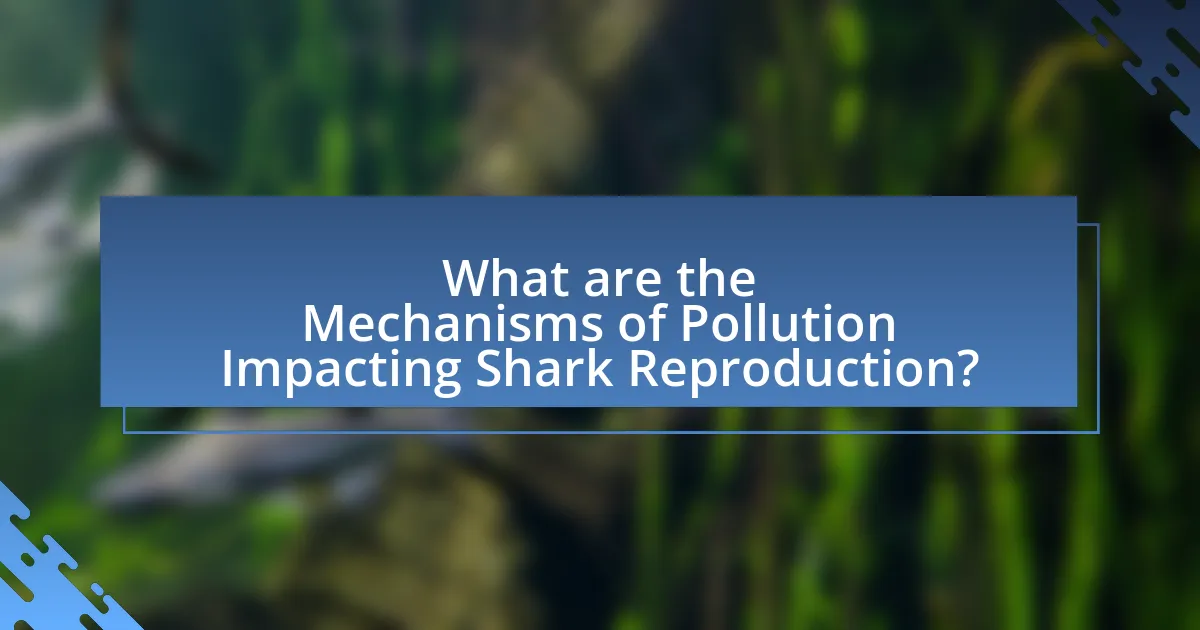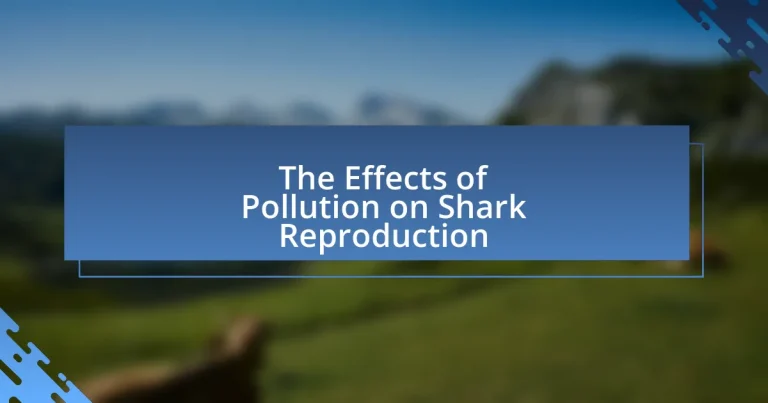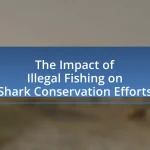The article examines the detrimental effects of pollution on shark reproduction, highlighting how pollutants such as heavy metals, plastics, and endocrine-disrupting chemicals disrupt hormonal systems and lead to developmental abnormalities. It details the mechanisms through which these contaminants impair reproductive health, including reduced fertility rates and increased embryo mortality. The article also discusses the ecological significance of shark reproduction for marine ecosystems, the role of sharks as apex predators, and the long-term consequences of declining shark populations. Additionally, it outlines potential solutions and conservation strategies to mitigate pollution’s impact on shark reproductive health.

What are the Effects of Pollution on Shark Reproduction?
Pollution negatively impacts shark reproduction by disrupting hormonal systems and causing developmental abnormalities. Specifically, pollutants such as heavy metals, plastics, and endocrine-disrupting chemicals can interfere with the reproductive hormones of sharks, leading to reduced fertility rates and altered reproductive behaviors. Research has shown that exposure to these contaminants can result in lower egg viability and increased mortality rates in embryos, ultimately affecting population dynamics. For instance, a study published in the journal “Marine Pollution Bulletin” by researchers from the University of Miami found that sharks exposed to certain pollutants exhibited significant reproductive impairments, highlighting the critical link between environmental health and shark reproductive success.
How does pollution impact shark reproductive health?
Pollution adversely affects shark reproductive health by disrupting endocrine functions and causing developmental abnormalities in embryos. Chemical pollutants, such as heavy metals and persistent organic pollutants, can accumulate in shark tissues, leading to hormonal imbalances that impair reproductive processes. Research indicates that exposure to these contaminants can result in reduced fertility rates, altered sex ratios, and increased mortality of embryos, as demonstrated in studies like those conducted by the National Oceanic and Atmospheric Administration, which found that sharks exposed to high levels of pollutants exhibited significant reproductive impairments.
What specific pollutants affect shark reproduction?
Specific pollutants that affect shark reproduction include heavy metals, polychlorinated biphenyls (PCBs), and pharmaceuticals. Heavy metals like mercury can accumulate in shark tissues, leading to reproductive issues such as reduced fertility and developmental abnormalities in embryos. PCBs, which are industrial chemicals, have been shown to disrupt endocrine functions, impacting hormone levels crucial for reproduction. Additionally, pharmaceuticals found in marine environments can interfere with reproductive processes, causing changes in behavior and reproductive success. Studies have demonstrated that exposure to these pollutants correlates with adverse reproductive outcomes in various shark species, highlighting the significant impact of environmental contaminants on their reproductive health.
How do these pollutants enter shark habitats?
Pollutants enter shark habitats primarily through runoff from land, industrial discharges, and atmospheric deposition. Agricultural practices contribute significantly, as fertilizers and pesticides wash into coastal waters during rainfall, leading to nutrient loading and chemical contamination. Additionally, urban runoff carries pollutants from roads and sewage systems directly into marine environments. Industrial activities release heavy metals and chemicals into waterways, which can accumulate in shark habitats. Studies indicate that these pollutants can adversely affect shark reproduction by disrupting endocrine functions and causing developmental abnormalities.
Why is shark reproduction important for marine ecosystems?
Shark reproduction is crucial for marine ecosystems because it ensures the continuation of shark populations, which play a vital role in maintaining the balance of marine life. Sharks are apex predators, and their presence helps regulate the populations of other marine species, preventing overpopulation and promoting biodiversity. Research indicates that healthy shark populations contribute to the stability of coral reef ecosystems by controlling the numbers of herbivorous fish, which in turn affects the health of coral reefs. For instance, a study published in the journal “Ecology Letters” found that areas with higher shark populations had more diverse and resilient marine ecosystems. Thus, the reproductive success of sharks directly influences the overall health and functionality of marine environments.
What role do sharks play in maintaining ecological balance?
Sharks play a crucial role in maintaining ecological balance as apex predators, regulating the populations of various marine species. By preying on weaker or sick individuals, sharks help maintain the health of prey populations, which in turn supports the overall health of marine ecosystems. For instance, studies have shown that the decline of shark populations can lead to an increase in smaller predator species, which can overconsume herbivorous fish, resulting in the degradation of coral reefs and other habitats. This trophic cascade illustrates how sharks are integral to the stability and resilience of marine environments.
How does a decline in shark populations affect other marine species?
A decline in shark populations negatively impacts other marine species by disrupting the balance of marine ecosystems. Sharks are apex predators, and their reduction leads to an increase in the populations of smaller fish and invertebrates, which can result in overgrazing of seagrass and coral reefs. For instance, studies have shown that the removal of sharks can lead to a significant rise in the numbers of herbivorous fish, which in turn can decimate seagrass beds, crucial habitats for many marine organisms. This cascading effect illustrates the critical role sharks play in maintaining the health and stability of marine environments.

What are the Mechanisms of Pollution Impacting Shark Reproduction?
Pollution impacts shark reproduction through several mechanisms, including chemical contamination, habitat degradation, and altered prey availability. Chemical contaminants, such as heavy metals and persistent organic pollutants, can disrupt endocrine functions in sharks, leading to reproductive abnormalities and decreased fertility. Habitat degradation, caused by pollution, reduces the availability of critical breeding and nursery areas, negatively affecting shark populations. Additionally, pollution can alter the abundance and health of prey species, which can further impact the reproductive success of sharks by limiting food resources necessary for gestation and nurturing young. Studies have shown that exposure to pollutants can lead to reduced reproductive rates and increased mortality in shark populations, highlighting the significant threat pollution poses to their reproductive health.
How do pollutants affect shark hormones and reproductive processes?
Pollutants significantly disrupt shark hormones and reproductive processes by acting as endocrine disruptors. These chemicals, such as heavy metals and persistent organic pollutants, can interfere with hormone signaling pathways, leading to altered reproductive behaviors, reduced fertility, and developmental abnormalities in embryos. Research has shown that exposure to these pollutants can result in lower testosterone levels in male sharks and altered estrogen levels in females, which directly impacts their reproductive success. For instance, a study published in the journal “Marine Pollution Bulletin” by researchers from the University of Miami found that sharks exposed to high levels of polychlorinated biphenyls (PCBs) exhibited impaired reproductive functions, highlighting the detrimental effects of environmental contaminants on shark populations.
What are the effects of endocrine disruptors on shark reproduction?
Endocrine disruptors negatively affect shark reproduction by altering hormonal functions, which can lead to reproductive failures and developmental abnormalities. Research indicates that exposure to these chemicals can result in reduced fertility, skewed sex ratios, and impaired embryonic development in various shark species. For instance, studies have shown that pollutants like polychlorinated biphenyls (PCBs) and heavy metals can interfere with the endocrine system, causing disruptions in reproductive hormone levels. This interference can lead to issues such as delayed maturation and decreased reproductive success, ultimately impacting shark populations and their ecological roles.
How does pollution influence shark mating behaviors?
Pollution negatively influences shark mating behaviors by disrupting their chemical communication and reproductive processes. Specifically, pollutants such as heavy metals and endocrine-disrupting chemicals can interfere with the hormones that regulate mating behaviors, leading to altered reproductive cycles and reduced mating success. Research has shown that exposure to these pollutants can result in changes to the pheromones that sharks use to attract mates, ultimately affecting their ability to reproduce effectively. For instance, a study published in the journal “Marine Pollution Bulletin” highlighted that increased levels of pollutants in coastal waters correlated with decreased reproductive rates in several shark species.
What are the long-term consequences of pollution on shark populations?
Pollution has significant long-term consequences on shark populations, primarily through the disruption of their reproductive systems. Contaminants such as heavy metals, plastics, and chemicals can lead to decreased fertility rates, altered sex ratios, and developmental abnormalities in embryos. For instance, studies have shown that exposure to polychlorinated biphenyls (PCBs) can impair reproductive health in sharks, resulting in lower reproductive success and higher mortality rates among young sharks. Additionally, habitat degradation caused by pollution can reduce the availability of breeding grounds, further threatening shark populations. These factors collectively contribute to the decline of shark numbers, impacting marine ecosystems where sharks play a crucial role as apex predators.
How does reduced reproductive success affect shark population dynamics?
Reduced reproductive success negatively impacts shark population dynamics by decreasing the number of new individuals entering the population. This decline in recruitment can lead to population decreases, as evidenced by studies showing that species like the great white shark have experienced significant population declines due to low reproductive rates. For instance, research indicates that overfishing and habitat degradation have led to lower birth rates and higher juvenile mortality, which directly correlates with reduced population stability and resilience. Consequently, diminished reproductive success can result in long-term population declines, threatening the survival of various shark species.
What trends have been observed in shark reproduction due to pollution?
Pollution has led to a decline in shark reproduction rates, particularly through the disruption of endocrine systems. Research indicates that exposure to pollutants such as heavy metals and persistent organic pollutants can cause reproductive abnormalities, including reduced fertility and altered sex ratios. For instance, studies have shown that female sharks exposed to high levels of polychlorinated biphenyls (PCBs) exhibit lower reproductive success, as evidenced by a decrease in viable offspring. Additionally, the accumulation of microplastics in marine environments has been linked to developmental issues in shark embryos, further impacting population sustainability.
What Solutions Exist to Mitigate Pollution’s Effects on Shark Reproduction?
To mitigate pollution’s effects on shark reproduction, implementing stricter regulations on industrial discharges and agricultural runoff is essential. These regulations can significantly reduce the introduction of harmful chemicals and nutrients into marine ecosystems, which have been shown to disrupt reproductive processes in sharks. For instance, studies indicate that pollutants like heavy metals and endocrine disruptors can impair reproductive health, leading to decreased fertility and altered development in shark populations. Additionally, establishing marine protected areas can help create safer habitats for sharks, allowing them to reproduce without the stressors associated with polluted environments. Research has demonstrated that such protected areas can enhance biodiversity and improve the overall health of marine ecosystems, further supporting shark reproduction.
How can conservation efforts help protect sharks from pollution?
Conservation efforts can help protect sharks from pollution by implementing regulations that reduce harmful waste entering marine environments. These efforts include establishing marine protected areas, which limit industrial activities and reduce pollution sources, thereby safeguarding shark habitats. For instance, the establishment of the Papahānaumokuākea Marine National Monument in Hawaii has led to improved water quality and healthier ecosystems, benefiting shark populations. Additionally, public awareness campaigns and community engagement initiatives can promote sustainable practices that minimize pollution, further supporting shark conservation.
What strategies are being implemented to reduce pollution in shark habitats?
Strategies being implemented to reduce pollution in shark habitats include the establishment of marine protected areas (MPAs), stricter regulations on industrial discharges, and community-led clean-up initiatives. Marine protected areas help to limit human activities that contribute to pollution, thereby safeguarding critical habitats for sharks. Stricter regulations on industrial discharges aim to minimize harmful runoff and waste entering marine ecosystems, which is essential for maintaining water quality. Community-led clean-up initiatives engage local populations in removing debris and pollutants from coastal areas, directly benefiting shark habitats. These strategies are supported by research indicating that reducing pollution can enhance the reproductive success of shark populations, as cleaner environments promote healthier ecosystems.
How can public awareness campaigns contribute to shark conservation?
Public awareness campaigns can significantly contribute to shark conservation by educating the public about the ecological importance of sharks and the threats they face, such as pollution. These campaigns raise awareness about how pollutants can disrupt shark reproduction, leading to population declines. For instance, studies have shown that chemical pollutants can affect the hormonal systems of sharks, impairing their reproductive capabilities. By informing communities about these issues, awareness campaigns can foster support for conservation initiatives, promote sustainable practices, and encourage policy changes that protect shark habitats from pollution.
What actions can individuals take to support shark reproductive health?
Individuals can support shark reproductive health by reducing plastic waste and advocating for cleaner oceans. By minimizing plastic use, individuals can decrease the amount of pollution that affects marine ecosystems, which is crucial for shark breeding grounds. Research indicates that pollutants like microplastics can disrupt reproductive hormones in marine species, including sharks, leading to decreased reproductive success. Additionally, participating in beach clean-ups and supporting policies aimed at reducing ocean pollution can further enhance the health of shark habitats, thereby promoting their reproductive health.
How can responsible consumer choices impact pollution levels?
Responsible consumer choices can significantly reduce pollution levels by decreasing demand for products that contribute to environmental degradation. For instance, choosing sustainable products, such as those with minimal packaging or made from recycled materials, directly lowers waste generation and resource extraction, which are major pollution sources. According to the Environmental Protection Agency, reducing plastic use can prevent millions of tons of plastic waste from entering oceans, thereby protecting marine ecosystems, including shark habitats. Additionally, opting for locally sourced food reduces carbon emissions associated with transportation, further mitigating air and water pollution. These choices collectively lead to a healthier environment, which is crucial for the reproductive success of sharks and other marine life.
What are some best practices for reducing pollution in coastal areas?
Best practices for reducing pollution in coastal areas include implementing strict regulations on waste disposal, promoting sustainable agricultural practices, and enhancing public awareness about pollution impacts. Regulations, such as the Clean Water Act in the United States, limit the discharge of pollutants into waterways, thereby protecting coastal ecosystems. Sustainable agricultural practices, like reducing fertilizer runoff through buffer zones, help minimize nutrient loading in coastal waters, which can lead to harmful algal blooms detrimental to marine life, including sharks. Public awareness campaigns educate communities on the importance of keeping coastal areas clean, which can lead to increased participation in cleanup efforts and responsible waste management.

